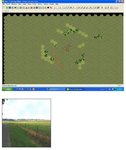I dont have the game you mention, but the east front series has won a total of five realism awards that I know of, whilst squad leader has been around forever, and is very realistic. Incidentally we dont need a "strategy" simulation, we need a tactical simulation
In order for me to let the computer test your scenario, you will need to send me a rough sketch of your map, a well as the forces you want me to feed into the simulation. I can also get some of my colleagues in the design group that i contribute to, to test out the scenario as independant observers. Its about a fair as I can gat i am afraid.
PLease give some thought to your map, and send it to me, I will then be able to complete the excercise and get back to you
Ok will do Parsifal.
However the reason I recommend Combat Mission 3 is because it uses an advanced armor penetration calculator taking into effect armor slope, angle of impact etc etc and it uses the the real life penetration figures as reference as well an advanced lethal range of explosive rounds.
I am not familiar with any of the games you mention except Panzer Leader, which is far from realistic.
You can read about Combat Mission here: Combat Mission: Afrika Korps Overview Page

